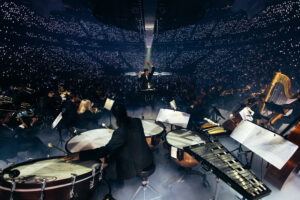MIAMI― Carlitos Lopez (Carlos Fernando Lopez) is a GRAMMY®– and Latin GRAMMY-winning producer, composer and conductor who seamlessly bridges the worlds of classical and popular music. Among Lopez’s notable works is co-producing Bad Bunny’s 2023 hit single “Nadie Sabe,” which features a full orchestral accompaniment to the artist’s electrifying music. Most recently, Lopez toured with Bad Bunny across the U.S., Canada and Puerto Rico, conducting the Philharmonic Orchestra Project (POP), which performed Bad Bunny’s songs. During the tour, POP also showcased a collection of Lopez’s original music compositions to open the shows.

“Benito (Bad Bunny) loves all styles of music and decided to open his album with a classical sound,” explains Lopez. “So, I wrote orchestral music for him to use with ‘Nadie Sabe’ and recorded with a full orchestra in Prague. Then, from that collaboration and while producing that song, Benito decided he wanted to take a full orchestra on tour and asked me to conduct. He also requested new orchestral pieces to open the show, which I turned around in just a few days.”
A native of Colombia, Lopez has been inspired by music his entire life, following in the footsteps of his opera singer grandfather, who ignited the passion. Whether in the studio or on the stage, Lopez continually strives to ensure his productions are top-of-class and insists on utilizing only the best gear to support his work. Included among Lopez’s preferred solutions is DPA Microphones, which he deployed for both his studio and live orchestral projects with Bad Bunny.
“We had a team of 12 engineers working on the tour, and from the very start I asked to have input on the microphones we would use,” says Lopez. “I had used a selection of DPA mics in the studio, when we recorded the orchestra, and I knew that I wanted to deliver the same sound to live audiences. The orchestra we recorded in the studio was much larger than the one we used on tour because the stage was smaller, so the mics played an important role in ensuring we didn’t lose the perception of a big ensemble.”
In the studio, Lopez says, “I have adopted a complete DPA sound system for orchestral applications. I have three 4006A Omnidirectional Microphones that I used in a Decca Tree to record the orchestra for Benito, and many other artists. That setup represents about 80% of my mix, and I think it’s amazing. For accents, I also have the 4099 CORE Instrument Microphones, which I use with the magnet clip to attach inside the piano, or they can go on the celesta or harp.”
On tour, Lopez utilized DPA 4099s for string instruments, such as violins, violas, cellos and double bass, as well as for the trombones. “We also used the 4011A Cardioid in the string sections; that’s a good one for a delicate and bright tone,” he adds. “For percussion, we used the 2011C Twin Diaphragm Mic and the 4018 Supercardioid. This tour was performed in the round, with the audience seated 360-degrees around the stage and the speakers situated all around the arenas. We had a huge bass drum and when he hit the drum the whole arena would tremble, which was iconic for the show. The 4018 did an amazing job handling that sound and our engineers were awesome with the entire production.”
In addition to traditional instruments, the orchestra also incorporated a Glockenspiel, similar to a celesta or small marimba. “While there were songs on the album that had orchestral music, others originally did not, so Benito asked me to write arrangements for all the songs,” continues Lopez. “If you listen to ‘Monaco,’ one of the songs I arranged for the tour, I wrote part of it for the Glockenspiel and I asked to use the 4006A for that piece. It sounded beautiful. Benito used that song and some of the other new arrangements during his performance at the Paris games. His team asked me which microphones I thought they should use during that set—of course I recommended DPA.”
Though the original recordings of the songs did not all incorporate orchestral elements, Lopez ensured that the tour performances were recorded. “The level of isolation that these little mics provided was mind-blowing,” he says. “Clarity and dynamics were crucial to me when selecting microphones because some of the mics were used to capture a range of instruments. Since we were playing for arenas of 20 thousand or more people, all the cheering and screaming from the fans could potentially overpower the PA system and the recordings, but the noise was almost non-existent ― even the bleed was totally isolated. The DPAs represent a certain degree of fidelity and perfectly capture the actual dynamic range of the instruments for both the live performances and accompanying recordings, and that’s a win for us.”
For Lopez, who has been a longtime DPA user, durability also had an important role in his mic selection. “We played more than 50 shows in four months, so I didn’t want to take microphones on tour with me that would break, and I know DPAs are very durable,” he continues. “After each performance, our team had to disassemble the stage in two minutes, by the clock. So, the mics were loaded in and out very quickly each night, but they held up throughout the entire tour.”
